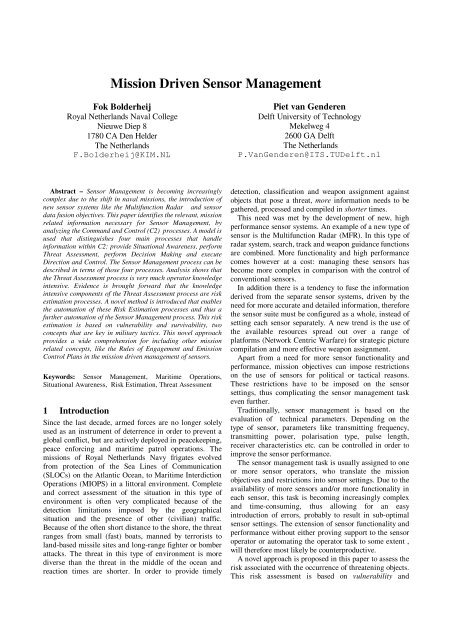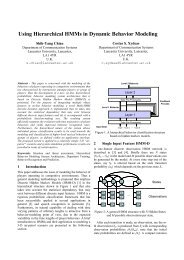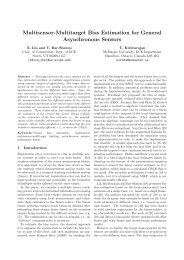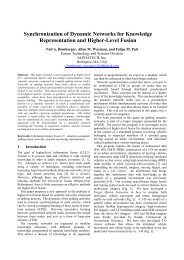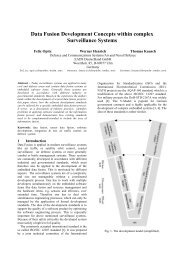Mission Driven Sensor Management - Information Fusion 2004
Mission Driven Sensor Management - Information Fusion 2004
Mission Driven Sensor Management - Information Fusion 2004
Create successful ePaper yourself
Turn your PDF publications into a flip-book with our unique Google optimized e-Paper software.
<strong>Mission</strong> <strong>Driven</strong> <strong>Sensor</strong> <strong>Management</strong><br />
Fok Bolderheij<br />
Royal Netherlands Naval College<br />
Nieuwe Diep 8<br />
1780 CA Den Helder<br />
The Netherlands<br />
F.Bolderheij@KIM.NL<br />
Piet van Genderen<br />
Delft University of Technology<br />
Mekelweg 4<br />
2600 GA Delft<br />
The Netherlands<br />
P.VanGenderen@ITS.TUDelft.nl<br />
Abstract – <strong>Sensor</strong> <strong>Management</strong> is becoming increasingly<br />
complex due to the shift in naval missions, the introduction of<br />
new sensor systems like the Multifunction Radar and sensor<br />
data fusion objectives. This paper identifies the relevant, mission<br />
related information necessary for <strong>Sensor</strong> <strong>Management</strong>, by<br />
analyzing the Command and Control (C2) processes. A model is<br />
used that distinguishes four main processes that handle<br />
information within C2: provide Situational Awareness, perform<br />
Threat Assessment, perform Decision Making and execute<br />
Direction and Control. The <strong>Sensor</strong> <strong>Management</strong> process can be<br />
described in terms of those four processes. Analysis shows that<br />
the Threat Assessment process is very much operator knowledge<br />
intensive. Evidence is brought forward that the knowledge<br />
intensive components of the Threat Assessment process are risk<br />
estimation processes. A novel method is introduced that enables<br />
the automation of these Risk Estimation processes and thus a<br />
further automation of the <strong>Sensor</strong> <strong>Management</strong> process. This risk<br />
estimation is based on vulnerability and survivability, two<br />
concepts that are key in military tactics. This novel approach<br />
provides a wide comprehension for including other mission<br />
related concepts, like the Rules of Engagement and Emission<br />
Control Plans in the mission driven management of sensors.<br />
Keywords: <strong>Sensor</strong> <strong>Management</strong>, Maritime Operations,<br />
Situational Awareness, Risk Estimation, Threat Assessment<br />
1 Introduction<br />
Since the last decade, armed forces are no longer solely<br />
used as an instrument of deterrence in order to prevent a<br />
global conflict, but are actively deployed in peacekeeping,<br />
peace enforcing and maritime patrol operations. The<br />
missions of Royal Netherlands Navy frigates evolved<br />
from protection of the Sea Lines of Communication<br />
(SLOCs) on the Atlantic Ocean, to Maritime Interdiction<br />
Operations (MIOPS) in a littoral environment. Complete<br />
and correct assessment of the situation in this type of<br />
environment is often very complicated because of the<br />
detection limitations imposed by the geographical<br />
situation and the presence of other (civilian) traffic.<br />
Because of the often short distance to the shore, the threat<br />
ranges from small (fast) boats, manned by terrorists to<br />
land-based missile sites and long-range fighter or bomber<br />
attacks. The threat in this type of environment is more<br />
diverse than the threat in the middle of the ocean and<br />
reaction times are shorter. In order to provide timely<br />
detection, classification and weapon assignment against<br />
objects that pose a threat, more information needs to be<br />
gathered, processed and compiled in shorter times.<br />
This need was met by the development of new, high<br />
performance sensor systems. An example of a new type of<br />
sensor is the Multifunction Radar (MFR). In this type of<br />
radar system, search, track and weapon guidance functions<br />
are combined. More functionality and high performance<br />
comes however at a cost: managing these sensors has<br />
become more complex in comparison with the control of<br />
conventional sensors.<br />
In addition there is a tendency to fuse the information<br />
derived from the separate sensor systems, driven by the<br />
need for more accurate and detailed information, therefore<br />
the sensor suite must be configured as a whole, instead of<br />
setting each sensor separately. A new trend is the use of<br />
the available resources spread out over a range of<br />
platforms (Network Centric Warfare) for strategic picture<br />
compilation and more effective weapon assignment.<br />
Apart from a need for more sensor functionality and<br />
performance, mission objectives can impose restrictions<br />
on the use of sensors for political or tactical reasons.<br />
These restrictions have to be imposed on the sensor<br />
settings, thus complicating the sensor management task<br />
even further.<br />
Traditionally, sensor management is based on the<br />
evaluation of technical parameters. Depending on the<br />
type of sensor, parameters like transmitting frequency,<br />
transmitting power, polarisation type, pulse length,<br />
receiver characteristics etc. can be controlled in order to<br />
improve the sensor performance.<br />
The sensor management task is usually assigned to one<br />
or more sensor operators, who translate the mission<br />
objectives and restrictions into sensor settings. Due to the<br />
availability of more sensors and/or more functionality in<br />
each sensor, this task is becoming increasingly complex<br />
and time-consuming, thus allowing for an easy<br />
introduction of errors, probably to result in sub-optimal<br />
sensor settings. The extension of sensor functionality and<br />
performance without either proving support to the sensor<br />
operator or automating the operator task to some extent ,<br />
will therefore most likely be counterproductive.<br />
A novel approach is proposed in this paper to assess the<br />
risk associated with the occurrence of threatening objects.<br />
This risk assessment is based on vulnerability and
survivability, two concepts that are key elements in<br />
military tactics. This novel approach provides a wide<br />
comprehension for including other mission related<br />
concepts, like the Rules of Engagement and Emission<br />
Control Plans in the mission driven management of<br />
sensors.<br />
Section 2 of this paper presents the current architecture<br />
of Command and Control Processes. The Observe-Orient-<br />
Decide-Act (OODA) loop model is used to identify the<br />
operator dependencies in these processes. Section 3<br />
discusses various modes of use of Multifunction Radar in<br />
the OODA loop. Section 4 proposes a tractable expression<br />
for the estimation of the level of risk posed by threat<br />
objects and discusses other use of the same concept.<br />
2 Structure of Command and Control<br />
Processes<br />
The operational processes responsible for mission control<br />
are often referred to as the Command and Control (C2)<br />
processes. Because in these processes all the relevant<br />
mission information is embedded, the required sensor<br />
management information has to be derived from them.<br />
Delft and Passenier [1] developed a C2 process model in<br />
which four main information handling processes are<br />
distinguished. These processes can be mapped on the<br />
classical, high-level processes in the Observe – Orient –<br />
Decide – Act loop (OODA loop) as described by<br />
Boyd [2]. This mapping is given in Table 1.<br />
OODA Process<br />
Observe<br />
Orient<br />
Decide<br />
Act<br />
Table 1 : OODA and C2 processes.<br />
C2 Process<br />
Provide Situational<br />
Awareness<br />
Perform Threat Evaluation<br />
Perform Decision Making<br />
Execute Direction and<br />
Control<br />
The relations between the C2 processes are given in<br />
Figure 1.<br />
<br />
<br />
<br />
Perform<br />
Threat<br />
Evaluation<br />
Provide<br />
Situation<br />
Awareness<br />
Orient<br />
Observe<br />
Perform<br />
Decision<br />
Making<br />
Execute<br />
Direction<br />
and<br />
Control<br />
Decide<br />
Act<br />
Fig. 1. The C2 processes.<br />
<br />
<br />
<br />
The information necessary to execute these processes is<br />
either available in these parts of the C2 processes, as<br />
implemented in the Combat <strong>Management</strong> System (CMS),<br />
or present as implicit operator knowledge. These<br />
processes are analysed in order to determine their current<br />
level of automation in combination with the missing<br />
information.<br />
The Situational Awareness process uses the sensor<br />
systems to detect, track and recognise objects in the<br />
operational environment. The delivered type of<br />
information is sensor dependent: radar systems provide<br />
range, bearing, elevation and velocity information; state of<br />
the art radars automatically generate plot and track<br />
information; optical sensors can be used for detection and<br />
recognition purposes and radar receiver data (Electronic<br />
Support Measures (ESM) equipment) can be used to<br />
detect the presence of objects by their electromagnetic<br />
emissions. Often some kind of <strong>Sensor</strong> Data <strong>Fusion</strong><br />
functionality is implemented in the CMS. In modern<br />
Combat Systems, the process of obtaining Situational<br />
Awareness is largely automated and is sometimes<br />
augmented by operator input.<br />
In the Treat Evaluation process the sensor data is<br />
analysed, interpreted and compiled into the so-called<br />
Recognised Picture. Objects are labelled (identified) as<br />
Friendly, Neutral or Hostile if the object is classified with<br />
enough certainty; it is identified as Assumed Friendly or<br />
Suspect if there is some doubt about the classification and<br />
as unknown if there is no certainty about the classification<br />
of the object. The identity assigned to an object depends<br />
on the threat the object poses to the mission objectives and<br />
the amount of certainty about the type of object<br />
(Classification Process). This of the latter depends on the<br />
available sensor information: kinematical data,<br />
recognition data or ESM data. Although supported by the<br />
Combat <strong>Management</strong> system, these processes still rely<br />
mainly on operator knowledge.<br />
The Decision Making process uses the Recognised<br />
Picture to plan the deployment of the available resources<br />
or the execution of other actions necessary for mission<br />
success. Once an object’s class has been established with<br />
some degree of certainty and the threat it poses to the<br />
mission has been determined, actions have to be<br />
considered if the threat is evaluated too high. Weapon<br />
systems (actuators) are directed to those objects that<br />
potentially can harm own assets thus reducing their<br />
(operational) value and hence endanger the mission<br />
objectives. The type of weapon system, if necessary in<br />
combination with a directing sensor is selected by a<br />
scheduler. Automation is often based on heuristics and<br />
kinematic properties of the threat object usually on a ‘first<br />
come, first serve’ basis. Because of the often short<br />
reaction times, the deployment of these systems is<br />
safeguarded by ‘fire inhibit’ switches: once the decision<br />
has been made to use force, firing is enabled and the<br />
Decision Making process decides about the choice of<br />
weapon and the best moment for deployment. The process<br />
itself is highly automated, decisions about the actions that<br />
are to be taken however are made by an operator.<br />
Once a decision has been made, the Direction and<br />
Control process executes the plans. Because modern
weapon systems are self-guiding or use the guidance<br />
provided by tracking systems this process is usually fully<br />
automated only to be supervised by an operator.<br />
3 <strong>Sensor</strong> <strong>Management</strong><br />
Next, the role of sensor management within the C2<br />
processes and the necessary information to run this<br />
process have to be determined. Because sensor systems<br />
deliver the necessary data for picture compilation in the<br />
Situational Awareness process, planning the way in which<br />
these resources are deployed can be described as a<br />
Decision Making process and controlling them as a<br />
Direction and Control process. The OODA loop can now<br />
be closed, using the Threat Evaluation processes to deliver<br />
the necessary input. An OODA loop based sensor<br />
manager can be constructed that uses sensor data as input,<br />
evaluates it, plans the deployment of the sensor resources<br />
and adjusts the sensors based upon this evaluation.<br />
Blackman and Popoli [3] describe a template for <strong>Sensor</strong><br />
<strong>Management</strong> design consisting of two loops:<br />
1. A loop controlled by a ‘Macro <strong>Sensor</strong> Manager’<br />
assigning the tasks that need to be accomplished to<br />
generate the Recognised Picture;<br />
2. A loop controlled by a ‘Micro <strong>Sensor</strong> Manager’<br />
optimising the assigned tasks.<br />
Once the Macro <strong>Sensor</strong> Manager has allocated a task to<br />
the Micro <strong>Sensor</strong> Manager, the task can be controlled by<br />
technical parameters and no operator input is necessary as<br />
long as the operational conditions do not change. The<br />
described Macro <strong>Sensor</strong> Manager however needs operator<br />
information for Threat Evaluation and Decision Making<br />
purposes in order to schedule the individual tasks and<br />
allocate the available budget.<br />
In traditional sensor systems different tasks are assigned<br />
to different sensors: search tasks are assigned to search<br />
radars; target acquisition is accomplished by target<br />
acquisition radars and tracking and illumination is done by<br />
track radars. Because dedicated radars are available to<br />
perform different tasks, there is not much need for budget<br />
allocation. The only experience available in task<br />
scheduling and budget allocation is related to the<br />
deployment of mechanical Single Target Trackers for<br />
Weapon Assignment purposes: once the decision has been<br />
made to deploy a guided Weapon System, a scheduler<br />
selects the missile in combination with a directing sensor.<br />
The characteristics of this type of scheduling mechanism<br />
fit the needs of a sensor manager for weapon direction; it<br />
does however not reserve sensor capacity for not yet<br />
detected, potentially more dangerous objects and is<br />
therefore not suited for scheduling MFRs or complete<br />
sensor suites. In modern MFRs, allocated search budget is<br />
not available for tracking purposes, and the illumination of<br />
an object will seriously drain the available budget.<br />
Priorities have to be assigned to these different tasks.<br />
Various scheduling mechanisms dealing with this<br />
problem are proposed in literature. For instance Huizing<br />
and Bloemen [4] propose a scheduling algorithm for an<br />
MFR, based upon operator assigned task priorities. The<br />
question that remains to be answered in this algorithm is<br />
on what basis these priorities have to be assigned.<br />
Komorniczak et al. [5], describe a prioritising mechanism<br />
based upon the kinematical properties of a threat object<br />
once this object is detected; this mechanism could be used<br />
to assign the priorities required for the tracking functions<br />
in [4] but it needs to be expanded for assigning priorities<br />
to search functions.<br />
Earlier in this Section, the conclusion was drawn that<br />
the Threat Evaluation process generated the input of the<br />
<strong>Sensor</strong> <strong>Management</strong> process; the priorities connected to<br />
the different tasks should be based on the output of this<br />
process. With this conclusion we return to the original<br />
objective, the (partial) automation of the <strong>Sensor</strong><br />
<strong>Management</strong> process, now specifically oriented at the<br />
Threat Evaluation process, because this process is<br />
operator knowledge intensive.<br />
4 Risk Estimation<br />
As stated before, the threat posed by an object is directly<br />
related to the amount of damage the object is able to<br />
inflict on our assets, thus reducing their (operational)<br />
value and the chances of mission success. Two important<br />
aspects come forward here: firstly the aspect of<br />
probability of mission success which is related to the<br />
failure of the threat objects and secondly the aspect of<br />
(operational) costs. These two factors are the most<br />
mentioned parameters in the concept of risk. Currently the<br />
estimation of the risk posed by threat objects is performed<br />
by mental processes executed by an operator. These<br />
processes will now be analysed in order to automate them.<br />
If it is possible to estimate the risk related to a threat<br />
object, those objects could be ranked in accordance to the<br />
risk, thus providing input for sensor function assignment<br />
and budget allocation. Because there are no restrictions<br />
with respect to the location of those sensors, a sensor<br />
manager that is based on risk estimation could also be<br />
used in a Network Centric Warfare role.<br />
In literature a number of definitions of Risk are given:<br />
Bedford and Cooke [6] describe Risk Analysis as an<br />
attempt to answer the following three questions:<br />
1. What can happen<br />
2. How likely is it to happen<br />
3. Given it occurs, what are the consequences<br />
Yellman [7] states that there are three facets of risk:<br />
1. Expected Loss;<br />
2. Variability of the losses;<br />
3. Uncertainty of the mental model.<br />
All those definitions and descriptions have in common the<br />
combination of the consequences of an unwanted<br />
phenomenon (costs or losses) and the probability of<br />
occurrence of this phenomenon (uncertainty).<br />
Romberg [8] describes how search can be used during a<br />
mission to reduce the risk posed by threat objects. Risk is<br />
calculated according to:<br />
I<br />
<br />
K<br />
∏<br />
r(<br />
n)<br />
= v(<br />
i,<br />
n)(1<br />
− (1 − L(<br />
k)<br />
P ( i,<br />
k,<br />
n)))<br />
(1)<br />
i= 1 k = 1<br />
f
where:<br />
RISK<br />
<br />
= N<br />
n=<br />
0<br />
• N = total mission time;<br />
• I = number of own assets;<br />
• K = number of threat objects<br />
• V = value of asset i at time n;<br />
r( n)<br />
(2)<br />
• L = lethality of threat object k (probability);<br />
• P f = probability of threat object k reaching asset i<br />
undetected;<br />
• RISK = the total risk during the mission.<br />
Here the assumption is made, that the detection of a threat<br />
object automatically results in its neutralisation. Eq. (1)<br />
contains all the necessary elements to estimate the risk<br />
posed by each object in the recognised picture, but also<br />
supports the estimation of the risk posed by not yet<br />
detected objects (intelligence). The recognised picture<br />
consisting of K 1 detected objects therefore has to be<br />
supplemented with K 2 imaginary threat objects, where the<br />
total number of threat objects K is the sum of K 1 and K 2 .<br />
For each of the threat objects (both real and imaginary) a<br />
risk estimation is executed. The estimated risk now<br />
directly translates into a sensor priority: a high risk yields<br />
a high priority. The type of the threat object relates to the<br />
necessary sensor function: a real (detected) threat object<br />
has to be tracked by the sensor; an imaginary object<br />
relates to a search function. If absolute certainty about the<br />
number of threat objects belonging to a certain class is<br />
available, the imaginary object can be removed from the<br />
Recognised Picture once all the threat objects from this<br />
class are detected and the search activities for this type of<br />
object can be ceased.<br />
In our approach eq. (1) is adapted to fit the needs of the<br />
sensor scheduler:<br />
I<br />
<br />
K<br />
∏<br />
r(<br />
i,<br />
k)<br />
= v(<br />
i)(1<br />
− (1 − L(<br />
i,<br />
k)<br />
P ( i,<br />
k)))<br />
(3)<br />
i= 1 k = 1<br />
Because the mission duration is not known and it is the<br />
instantaneous risk we are interested in, the time aspect is<br />
eliminated. Furthermore L(k) is expanded into L(i,k)<br />
because the lethality of a threat object depends on the<br />
interaction of a specific threat object and a specific asset:<br />
a certain type of missile will have a different impact on a<br />
non armoured frigate than on a heavily armoured cruiser.<br />
The final adaptation of the algorithm lies in the change of<br />
P f into P occ . This is more than only nomenclature: P occ is<br />
defined as the probability of the occurrence of an<br />
unwanted event inflicted by a threat object. The<br />
contribution of all the underlying events leading to this<br />
final, lethal event, like the failure to destroy the missile<br />
using hard kill systems or distract it by means of soft kill<br />
systems will be taken into account.<br />
Other important information can be derived from (3):<br />
L(i,k)P occ (i,k) gives the vulnerability of asset i in relation<br />
occ<br />
with threat object k and (1- L(i,k)P occ (i,k)) yields the<br />
related survivability.<br />
To estimate the probability of occurrence, the Failure<br />
Mode Effects Analysis (FMEA) as described by Bedford<br />
and Cooke [5] was used. This method has proven its<br />
merits in risk analyses in the aircraft industry and the<br />
construction of nuclear power plants. To demonstrate the<br />
suitability of this method, the probability of occurrence of<br />
a hit by an active homing missile (threat object) will be<br />
estimated, based on the probabilities of underlying events.<br />
At first, a state diagram is constructed (Fig. 2.), showing<br />
the different missile states and the state transitions.<br />
Crashed<br />
Target Not<br />
Detected<br />
Target Missed<br />
In Launcher In Flight Homing<br />
Missile Not<br />
Detected<br />
Missile Detected/<br />
Not Destroyed<br />
Missile Destroyed<br />
Fig. 2. Missile State Diagram.<br />
The missile states that were distinguished are:<br />
• In Launcher;<br />
• In Flight (midcourse);<br />
• Crashed (own assets not detected) ;<br />
• Homing (terminal illumination);<br />
• Detonated (own asset hit);<br />
Detonated<br />
Killed<br />
• Killed (destroyed by own assets).<br />
Analogous to the construction of a fault tree in the FME<br />
Analysis, an event tree was built (Fig. 3.) based on the<br />
events that cause a state transition.<br />
Intend<br />
to<br />
Launch<br />
Able<br />
to<br />
Launch<br />
In<br />
Range<br />
Detected<br />
Missile<br />
In<br />
Launcher<br />
Detected<br />
Intend<br />
to Use<br />
Able<br />
to<br />
Use<br />
In<br />
Range<br />
Missile<br />
In Flight<br />
Hard<br />
Killed<br />
Soft<br />
Killed<br />
Launcher<br />
Intend<br />
to<br />
Home<br />
Detected<br />
Missile<br />
Homing<br />
Missile<br />
Missile<br />
Detonated<br />
Fig. 3. Event Tree resulting in Missile Detonation<br />
Ship
These events can be divided into three main categories:<br />
1. Events related to the launcher;<br />
2. Events related to the missile;<br />
3. Events related to the own assets;<br />
The underlying events should be broken down to a level<br />
where the probabilities of occurrence of those events can<br />
either be estimated by experts or derived from historical,<br />
statistical or technical data. For instance, the conditions<br />
that lead to the launch of the missile are:<br />
• The opponent intends to launch (intention to<br />
launch);<br />
• Both the launcher and the missile are in a sufficient<br />
technical condition (able to launch);<br />
• Our asset is in range;<br />
• Our asset is detected by the opponent.<br />
If these conditions are met, the missile will be launched.<br />
The probabilities of occurrence of underlying events now<br />
have to be determined. The opponent’s intentions depend<br />
on the current conflict level; the estimation of this<br />
probability has to be based on expert knowledge. The<br />
probability of a successful launch by the opponent can be<br />
derived from observations of trials and the estimation of<br />
the technical condition of the launcher and the missile.<br />
The missile’s performance determines whether our asset is<br />
in range. An estimation of environmental factors, the<br />
opponent’s sensor capacity and observed reconnaissance<br />
yields the probability of detection.<br />
The combination these probabilities as the input of a<br />
logical And Gate construction, using Bayesian Calculus<br />
results in the probability of the event Missile Launch. This<br />
event in its turn is an necessary precondition for the<br />
Missile Homing event. In a similar way the other<br />
underlying events are combined into the Missile<br />
Detonated event and its related probability of occurrence.<br />
After the construction of the event tree was finished, it<br />
became apparent that the tree could be used as a<br />
knowledge base; the detection of a missile leads to the<br />
conclusion that the underlying events have taken place;<br />
the opponent apparently had the intention to launch, the<br />
launcher and the missile were in good condition, our asset<br />
was in range and was detected. This provides some<br />
knowledge about to the future deployment of other threat<br />
objects, thus offering assistance in the Decision Making<br />
process.<br />
It is also possible to use the event tree to visualise the<br />
implications of mission imposed restrictions (e.g. Rules<br />
Of Engagement, Emission Control plans) or<br />
malfunctioning equipment: these restrictions or<br />
malfunctions will have an impact on the deployment of<br />
own sensors and actuators; thus increasing the chances of<br />
success of the threat objects i.e. the probability of<br />
occurrence of the unwanted phenomenon.<br />
Once the probability of occurrence of the unwanted<br />
phenomenon caused by an asset /threat object interaction<br />
is estimated, the resulting risk can be determined using<br />
equation (3); assuming that an asset’s operational value<br />
and a threat object’s lethality are already determined.<br />
Analysis of the event tree provides a set of<br />
countermeasures: to prevent the launch of a missile, one<br />
of the following conditions has to be satisfied :<br />
• the conflict level is reduced by holding peace<br />
negotiations;<br />
• the launcher is taken out by a pre-emptive strike;<br />
• assets are kept out of weapon range;<br />
• detection is avoided.<br />
The effect of each of these countermeasures could be<br />
calculated by estimating the related risks. With respect to<br />
the <strong>Sensor</strong> <strong>Management</strong>, risk could be reduced by<br />
enhancing the Probability of Detection and Track<br />
Accuracy for hard and soft kill countermeasures. It is clear<br />
that failure of detection directly results in a missile hit if<br />
the missile system is not malfunctioning. Once the missile<br />
is detected it has to be neutralised by the either the hard<br />
kill or soft kill systems.<br />
5 Conclusion<br />
The description of <strong>Sensor</strong> <strong>Management</strong> process in terms<br />
of the OODA loop processes provides a way to construct a<br />
<strong>Sensor</strong> <strong>Management</strong> System that is controlled by<br />
operational information. This information is to a great<br />
extent available within the C2 processes except for the<br />
risk estimation information.<br />
The implementation of the described risk estimation<br />
process in the Threat Evaluation processes provides a tool<br />
to accomplish automatic Threat Ranking and offers<br />
support for the Decision Making processes. The<br />
combination of information provided by the<br />
Classification, Identification and the Risk Estimation<br />
processes enable the automation of sensor function<br />
assignment and budget allocation to a large degree, thus<br />
supporting the effective use of complex sensors like the<br />
Multi Function Radar and also enables the management<br />
of sensors located at different platforms.<br />
Acknowledgements<br />
This work is part of the STATOR research program on<br />
sensor management supported by Thales Naval<br />
Nederland, the Royal Netherlands Naval College, and the<br />
International Research Center for Telecommunicationstransmission<br />
and Radar of the Delft University of<br />
Technology.<br />
In order to support this research many interviews were<br />
made with staff of the Royal Netherlands Navy. Their<br />
willingness to share their views on the Command and<br />
Control process functions and operator roles is greatly<br />
appreciated.<br />
References<br />
[1] J.H. van Delft and P.O. Passenier. Functions and<br />
tasks in current CIC, In J.H. van Delft and H.<br />
Schuffel, editors, Human Factors research for future<br />
RNLN Combat <strong>Information</strong> Centers. TNO-TM 1995
A-19, TNO-TM, Soesterberg, The Netherlands,<br />
1995 (in Dutch).<br />
[2] Boyd, John R. A Discourse on Winning and Losing.<br />
Unpublished briefing notes. Various editions, 1987-<br />
1992.<br />
[3] Samuel Blackman and Robert Popoli. Design and<br />
Analyis of Modern Tracking Systems, pages 1004-<br />
1018, Artech House, Norwood , MA, 1999.<br />
[4] Albert G. Huizing and Axel A.F. Bloemen. An<br />
Efficient Scheduling Algorithm for a Multi Function<br />
Radar, IEEE int. symp. on Phased Array Systems and<br />
Technology. 0-7803-3232-6/96, IEEE, 1996.<br />
[5] Wojciech Komorniczak, Tomasz Kuezerski and Jerzy<br />
F. Pietrasinski. The priority assignment for detected<br />
targets in Multi-Function Radar, Proc. 13 th Int. Conf.<br />
On Microwaves, Radar and Wireless<br />
Communications, pages 244-247, Mikon, 2000<br />
[6] Tim Bedford and Roger Cooke, Probabilistic Risk<br />
Analysis: Foundations and Methods, Cambridge<br />
University Press, pages 10, 99-120, Cambridge, UK,<br />
2001.<br />
[7] Ted W. Yellman. The Three Facets of Risk Proc.<br />
2000 World Aviation Conference. October 10-12,<br />
2000, San Diego, CA, American Institute of<br />
Aeronautics and Astronautics, Washington, DC,<br />
2000.<br />
[8] Harland Romberg. A game theoretic approach to<br />
search AIAA Guidance, Navigation, and Control<br />
Conference and Exhibit, Denver, CO, 14-17 August<br />
2000. AIAA-2000-4052, 2000


